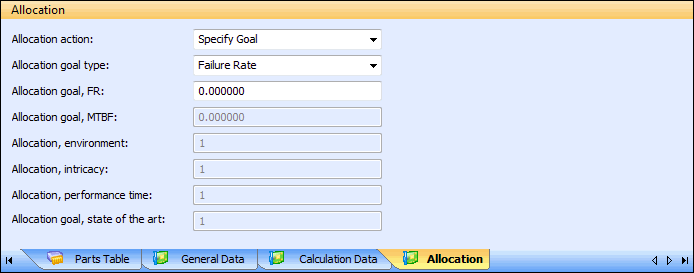Feasibility of Objectives Method
The following form is shown in the Allocation pane for an assembly when Feasibility of Objectives is selected for Allocation method under Prediction in the System file properties.

The following table describes the data fields in the Allocation pane for the feasibility of objectives method. Field availability depends on selections made in various fields. For more information, see Feasibility of Objectives Allocation Method Calculations.
Field | Description |
|---|---|
Allocation action | The way in which to allocate the failure rate or MTBF value for the assembly. Choices are: • Specify Goal — When selected, the failure rate or MTBF desired for the assembly is entered. Allocation goal type becomes available so that you choose whether you want to supply a a failure rate or MTBF goal. • Perform Allocation.— When selected, a weight factor is computed as a function of the four numeric ratings entered in the last four fields, which become available. For the top-most assembly, this choice is invalid. |
Allocation goal type | Indicates whether the goal to enter is a failure rate or MTBF value. This field is available when Specify Goal is selected for Allocation action. • Failure Rate — When selected, Allocation goal, FR becomes available so that you can enter the desired failure rate. • MTBF — When selected, Allocation goal, MTBF becomes available so that you can enter the desired MTBF. |
Allocation goal, FR | The desired failure rate goal for the assembly. This field is available when Failure Rate is selected for Allocation goal type. |
Allocation goal, MTBF | The desired MTBF goal for the assembly. This field is available when MTBF is is selected for Allocation goal type. |
Allocation, environment | A value of 1 to 10 that indicates the environmental conditions in which the active subsystem (assembly) operates. A subsystem that is to operate in a very mild environment is rated at 1, and a subsystem that is to operate in a very harsh or severe environment is rated at 10. |
Allocation, intricacy | A value of 1 to 10 that indicates the probable number of parts or components making up the active subsystem as well as the assembled intricacy of its parts or components. A subsystem with little or no intricacy is rated at 1, and a highly intricate subsystem is rated at 10. |
Allocation, performance time | A value of 1 to 10 that considers how long the subsystem operates during the entire mission time. A subsystem that operates only a very small amount of the mission time is rated at 1, and a subsystem that operates for the entire mission time is rated at 10. |
Allocation, state of the art | A value of 1 to 10 that indicates how technologically advanced the design of the active subsystem is. The present technological progress in all engineering fields is weighed. The most highly developed design or method is rated at 1, and the least developed design or method is rated at 10. |